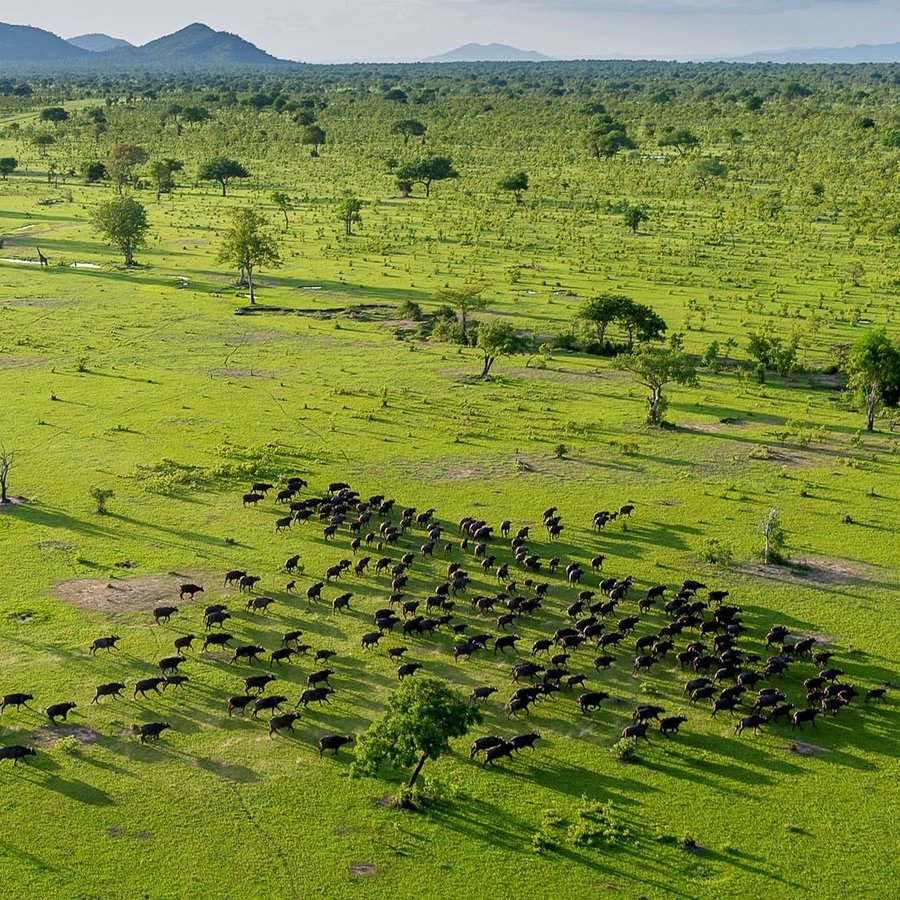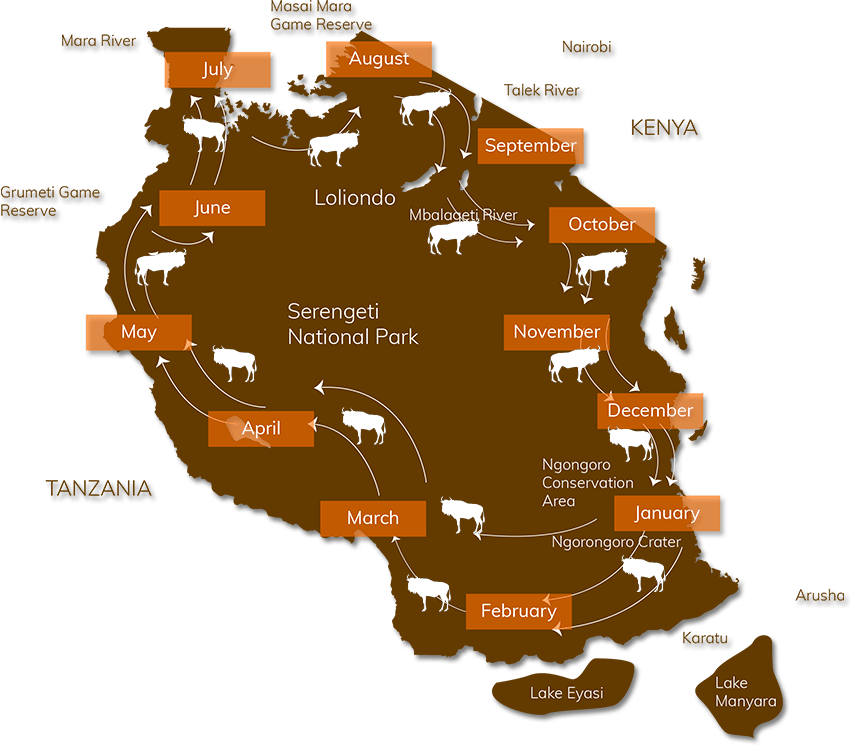The Great Wildebeest Migration
The Great Wildebeest Migration — Earth’s Grandest Wildlife Spectacle
The Great Wildebeest Migration stands as one of Serengeti National Park’s most remarkable spectacles. Regarded as one of the world’s seven natural wonders, this annual event unfolds in various sectors of the Serengeti. A highlight is the transboundary migration between Tanzania’s Serengeti and Kenya’s Maasai Mara National Reserve, involving crossings at the Mara River, east of the Grumeti River, and through Lobo. This phenomenon is celebrated globally in the tourism and hospitality industry, drawing millions of visitors eager to witness the “World Cup of wildlife” at the Mara River, where crocodiles act as the referees, preying on the vast herds of wildebeest and zebras making their perilous crossing into the Maasai Mara. The region near the Gol Mountains, at the northern edge of the Ngorongoro Conservation Area, boasts the highest concentration of cheetahs in the Serengeti. Serengeti National Park offers exceptional wildlife viewing year-round, particularly in areas like Seronera, Grumeti River, and Ndutu. The wildebeest migration traverses five distinct sectors of the park, each occurring at different times of the year, solidifying Serengeti National Park’s reputation as one of Africa’s premier wildlife destinations.
Southern Wildebeest Migration
The Southern Serengeti wildebeest migration commences in late December, reaching its peak in January, before the herds begin their return to the central Serengeti in March. This period, known as the calving season, unfolds across the southern Serengeti and the northern Ngorongoro Conservation Area, particularly in the Ndutu region. During this time, the plains of Kusini and Maswa Game Reserve become vital grazing grounds for the herds. The Kusini kopjes serve as natural shelters for predators such as cheetahs, leopards, and lions, who utilize these areas to ambush the grazing wildebeest. The calving season witnesses the birth of approximately 8,000 calves daily, attracting a surge in predator activity due to the abundance of vulnerable prey. As the wildebeest and zebras give birth, they congregate on the nutrient-rich plains of Ndutu to regain strength. The area also supports a diverse range of other grazers, including gazelles and impalas. The open grasslands of Ndutu provide ideal conditions for the young to feed and grow, with fresh, nutritious grass available. By February, the herds begin their journey back north through Kusini, where they continue to face challenges from predators along the way. The acacia woodlands and kopjes along their path offer hiding spots for predators, maintaining the cycle of survival and predation. Even after the wildebeest’s departure, these areas remain rich in wildlife, with various species depending on the protective microclimates of the kopjes. These kopjes collect water in basin-like rocks, providing a vital resource for wildlife, while predators like lions and jackals keep watch from above, ready to ambush any prey approaching to drink. The Southern Serengeti, especially around the Maswa Game Reserve, offers dry-season pasture for various animals, including buffaloes, impalas, and gazelles, making it a crucial area for wildlife throughout the year.
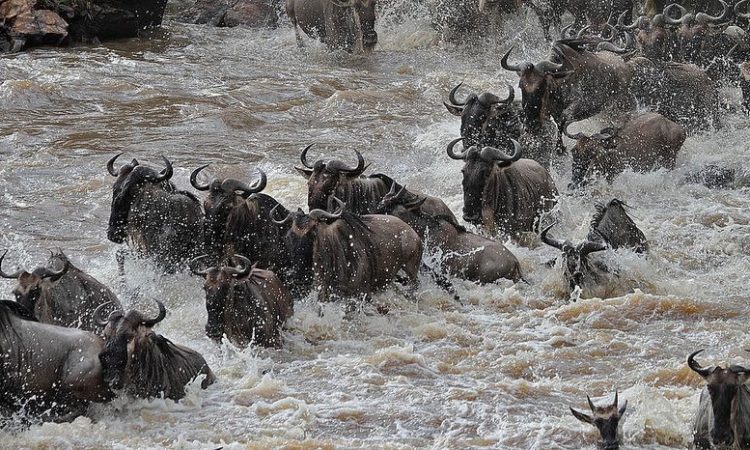
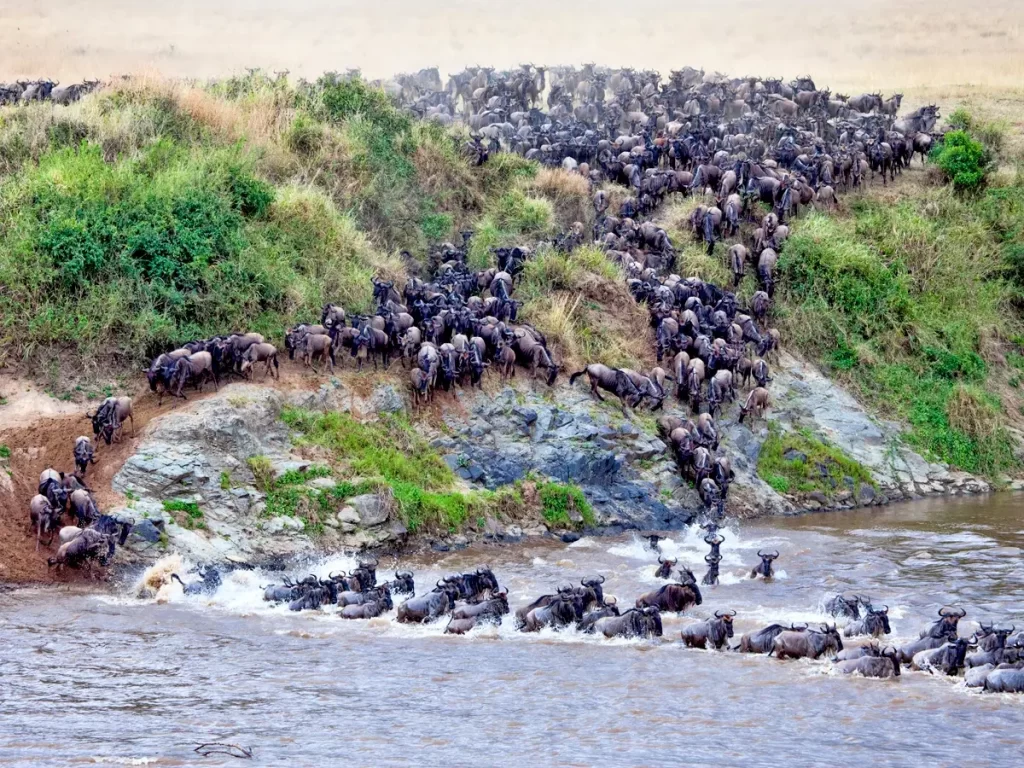
Western Serengeti Wildebeest Migration
The Western Serengeti wildebeest migration unfolds during the rainy season, typically from April to early June. During this period, large herds of wildebeest, accompanied by zebras, gazelles, and elands, traverse the Western Corridor of Serengeti National Park, south of the Grumeti River. This migration is among the most perilous, with high concentrations of predators both in the water—particularly giant crocodiles in the Grumeti River—and on land. The challenging terrain and abundant predators result in significant mortality among the migrating herds.
While Serengeti safaris offer an opportunity to witness this dramatic event, they also provide a chance to observe the permanent residents of the region. The area around the seasonal Mbalageti River, which runs dry during the dry season, supports a variety of wildlife, including black-and-white colobus monkeys, patas monkeys, olive baboons, impalas, topis, waterbucks, and various antelopes. Night drives in the private wilderness areas may reveal elusive nocturnal creatures such as leopards, porcupines, aardvarks, honey badgers, and bat-eared foxes.
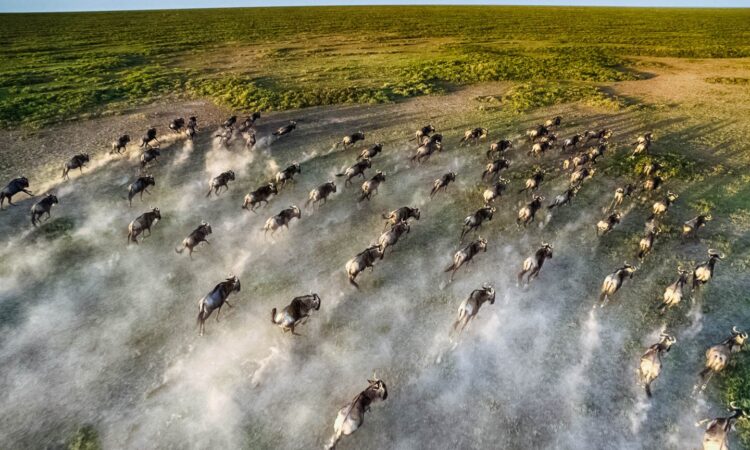
Northern Serengeti wildebeest migration
The Northern Serengeti wildebeest migration stands as one of the most renowned natural events globally, often hailed as one of the Seven Natural Wonders of the Animal Kingdom. This remarkable journey unfolds in the extreme northern reaches of Serengeti National Park, particularly around the Lamai Triangle, marking the largest and most dramatic phase of the migration. From July to September, the herds traverse the Mara River into Kenya’s Maasai Mara National Reserve, navigating the vast Serengeti-Mara ecosystem in search of fresh grazing grounds.
The spectacle intensifies as wildebeest and other grazers plunge into the river, contending with formidable Nile crocodiles lurking beneath the surface. The migration’s timing remains elusive to humans, yet predators instinctively position themselves, awaiting the opportune moment. The steep cliffs of the Rift Valley escarpment create deep riverbanks, making retreat impossible once the journey begins.
Beyond the riverbanks, the region teems with wildlife, including elusive leopards, hippos, hyraxes, and mongooses, enriching the migration experience. By October, the herds commence their return to Serengeti, completing a full circle of the migration. Travelers can witness the entire cycle by visiting Serengeti in July and Maasai Mara in October, immersing themselves in this extraordinary natural phenomenon.
The Great Wildebeest Migration is a globally recognized event, attracting travelers eager to witness one of nature’s most awe-inspiring spectacles. This migration transcends mere grazing; it embodies a dynamic interplay of survival, instinct, and the relentless pursuit of life across the plains.
Led by dominant males, the herds embark on their journey after careful coordination, moving towards the northern Serengeti to cross the Mara River into Kenya’s Maasai Mara. This cyclical migration spans three primary regions: the Ngorongoro Conservation Area, Serengeti National Park, and Maasai Mara National Reserve, each offering unique experiences as the wildebeest seek sustenance and water throughout the year.
From July to September, the herds migrate north to Maasai Mara in search of greener pastures, crossing the Mara River, a perilous journey that sees many succumb to predators. In October to November, they return to Serengeti, continuing the cycle of life and death in this vast ecosystem.
In the southern Serengeti, particularly around Kusini and Ndutu, the migration takes a different form. From January to February, female wildebeest lead the herds to calving grounds, giving birth to thousands of calves daily. This calving season attracts numerous predators, capitalizing on the abundance of vulnerable young. After this period, the herds begin their journey back north, traversing through Kusini and Ndutu, where survival remains a constant challenge amidst the ever-present threat of predators.
The Western Serengeti migration, occurring from April to early June, presents its own set of challenges. As the herds move westward and northward, they encounter the Grumeti River, home to massive crocodiles. This crossing is among the most perilous, with many wildebeest falling prey to the crocodiles or succumbing to exhaustion. The region also boasts unique wildlife, including black-and-white colobus monkeys, patas monkeys, and various nocturnal species like leopards and aardvarks, adding to the migration’s allure.
The Great Wildebeest Migration is a testament to the resilience and instinctual drive of wildlife. It’s a journey that captivates the imagination, offering travelers an unparalleled opportunity to witness one of Earth’s most extraordinary natural phenomena.
